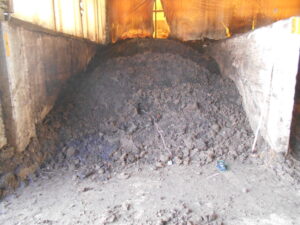Recycling and CO2 reduction by composting leftover tomatoes (by Iwaki Onahama Saien)
This is an example of improving a muddy situation caused by composting of high moisture content material by increasing fermentation temperature and reducing odor through improved aeration.
- Products Introduced
- Easy Jet
- Client and Location
- Fukushima Prefecture / Kagome Iwaki Onahama Saien Co., Ltd.
- Processed Material
- Tomato Residues (leaves, stems, fruit) 45m³/day
- Issue
- The high moisture content of the residues led to a muddy consistency, hindering the composting process
Overview of Composting at Iwaki Onahama Saien Co., Ltd.

Iwaki Onahama Saien Co., Ltd. in which Kagome Co., Ltd. has invested, has adopted Easy Jet as a composting system for tomato residue.
This facility is one of the largest tomato farms in Japan cultivated with nutrient solution, and is a high-tech vegetable garden with an area of 20 hectares (equivalent to four Tokyo Domes).
Measures and Effects
| Increased Processing Volume Through Improved Ventilation | The introduction of the Easy Jet has increased the throughput by stabilizing the fermentation of tomato residue with high water content, which had been muddy in rotary tank fermentation. |
|---|---|
| Reduction of bad odor by eliminating fermentation failure | With the Easy Jet, fermentation became stable, significantly reducing unpleasant odors |
| Increased Fermentation Temperature Due to Improved Ventilation | The Easy Jet raised the fermentation temperature from 30-40℃ to 60-70℃ |
| Cost Reduction Through Electricity Savings | Switching from a blower system to high-pressure ventilation reduced electricity costs by 30% |
| Improved compost quality by changing the mix and type of secondary materials | By reviewing the type and quantity of secondary materials, the composting process was stabilized and compost quality was improved |
Concerns Before Introduction

The farm grows tomatoes for fresh eating under the “Kokumi Tomato” brand, with an annual production of 3,000 tons.
The amount of leaves and stems pruned during cultivation amounts to 40 cubic meters (5 tons) per day.
The leaves and stems had been composted in the past, but the high moisture content of tomato residue 90% made fermentation difficult, and the challenge was how to further improve the quality of the compost.
Until now, composting had been carried out using a rotary-type agitator and blower ventilation from the floor, but the blower ventilation required cleaning and other maintenance, and the problem was that fermentation was not stable.
Introduction of “Easy Jet”

We changed the ventilation system to our Easy Jet and aimed to shorten the fermentation period and increase fermentation temperatures.
As a result, immediately after starting use, the fermentation temperature reached over 70℃, and the composting process is progressing smoothly at present.

Furthermore, we reduced the electricity consumption for compost production by 20% compared to before, achieving a reduction in electricity costs and CO2 emissions.
Tomatoes, compared to other hydroponically grown crops, produce a large amount of residue (such as stems and leaves). We offer solutions to efficiently compost such residues and reduce processing costs.
After Implementation

At our facility, 40 cubic meters of tomato residues (primarily pruned stems, leaves, and, depending on the season, unsellable fruit) are produced daily and are composted within 20 days.
The incoming tomato residues are first cut by a shredder and then fed into a rotary mixing tank. Easy Jet is installed on the floor of the mixing tank to promote fermentation.
The green leaves and stems are decomposed by aerobic microorganisms, and within a day, the temperature reaches over 70℃, turning brown within a few days.
The finished compost is sold to nearby farmers and general consumers.
Initial Fermentation State

Shredded Tomato Residues

Enlarged Photo of Tomato Residues
Fermentation a Few Days Later

Two Days After Fermentation (Fermentation Temperature is Over 70℃)

Front View of the Mixing Tank

Oxygen Concentration in the Compost
Oxygen levels in the area where easyJet is installed are also favorable.
Fermentation temperature is also favorable, recording over 70℃ during the winter season.

Appearance during Stirring
Summary
In the case of recycling food scraps, the composting know-how is quite different from that of livestock manure.
For this reason, operation and management after installation is very important, and this is an area in which we are also putting a lot of effort.
In the case of this facility, the fermentation temperature was maintained at 70℃ or higher when we visited in December, and composting was going smoothly.
Before the installation, the fermentation temperature was not high enough and the odor during fermentation was an issue, both of which have now been resolved.
Introduction of the Product

Composting Equipment
Easy Jet
Composting Equipment that requires no turning
A special nozzle supplies oxygen to the inside of the compost, eliminating the need for heavy machinery to turn the compost around. High-temperature fermentation in winter is realized, enabling production of high-quality compost.
writer
CORPORATIONMIRAIE
We are a plant manufacturer specializing in composting and recycling equipment. We provide comprehensive support to customers facing composting and odor issues and strive to strengthen production systems to improve productivity.







 Facebook
Facebook X
X Hatena
Hatena Poket
Poket




